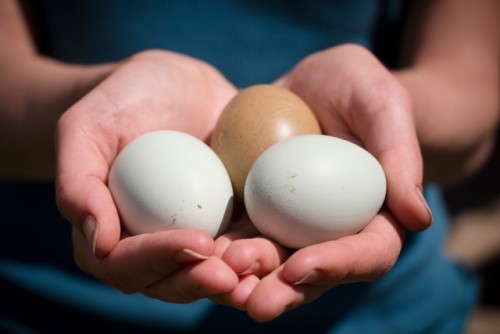It has been well established that calcium and magnesium are needed to maintain healthy bones and a well-functioning body.
What isn’t as well known is that using these (as well as other nutrients) in isolated form isn’t easy for our bodies. Many mineral supplements are derived from inorganic matter and, if not easily recognized and absorbed, can do more harm than good.
“Recommended daily allowances” are pushed, and therefore naturally considered by many people trying to keep their health in check—however, it doesn’t matter how many milligrams of anything we “should” be taking everyday if that supplement is going to burden our bodies.
I first learned about eggshell calcium from a chiropractic clinic that I regularly visited for preventative care. Amongst many other informational pamphlets, there was a write-up on the wall titled, “Lemon Egg.” Each time I glanced at the title I laughed, thinking it might be some sort of humorous insert amongst the more serious-sounding brochures.
I was instantly curious.
“Who can walk away from an intriguing tale of “lemon egg?!” I asked myself.
After spending a bit of time researching the nutrient profile of eggshells and being aware of the lacking assimilation abilities of many on-the-shelf calcium products, I decided it was worth trying and gave it a go. Not only would I be increasing my mineral intake, but I’d also have a good use for the eggshells that make their way to the compost every week.
Unlike many mineral supplements, which provide minerals in secluded form, eggshells offer a harmonic balance of elements. With a comparable composition to our bones and teeth; one whole medium sized eggshell provides about 750 – 800 milligrams of elemental (bioavailable or absorbable) calcium and over twenty other microelements.
In researching eggshell calcium, you’ll notice that some sources make mention of taking a matching amount of magnesium alongside the eggshell calcium content while others do not. Naturally, each of us should always make decisions based on what feels good and right for us. Because I avoid nutrients in isolated form, my personal approach has been to pair the nutrients from eggshells with magnesium and other mineral rich foods.
In order to maximize mineral absorption, try taking vitamin D. Perhaps a good cod liver oil during the colder months (I like Green Pastures fermented varieties); or soaking up plenty of sun during the warmer months.
Here are two at-home methods of extracting the calcium from egg shells.
In both of the methods listed below, any kind of egg can be used, but it is most beneficial to use eggs from pastured, happy, healthy birds. Aside from supporting the humane treatment of animals, eggs from unhealthy birds raised in confined, factory-like conditions will not have the same nutrient profile as eggs from humanely raised and well cared for birds.
1. Powdered Eggshell
- Remove egg white while leaving the nutrient membrane intact. Gently rinse empty eggshells.
- Spread the broken pieces out onto a dry towel and allow them to completely air dry.
- Break the eggshells up into small pieces and grind them into a fine powder using a small food processor, coffee grinder, or by placing them into a bag and using a rolling pin to “powder” them.
- Store powdered eggshells in a dry place in a covered glass jar or container.
- To pull the calcium out of the eggshell, place 1/2 teaspoon of the powdered eggshell into a small dish and add the fresh juice of one half of a lemon. Mix well—the mixture will start to bubble and foam.
- Leave at room temperature for at least six hours, but no longer than 12.
- Take 1/2-1 tsp.of this calcium mixture per day.
2. “Lemon-Egg”
- Place three clean, whole eggs in a wide-mouth jar.
- Cover the eggs with freshly squeezed lemon juice.
- Close the jar and place it in the refrigerator. You will begin to see bubbles forming on the eggs as the eggshells dissolve into the lemon juice.
- Gently agitate the jar a few times per day.
- After a day or two, when the bubbling stops, carefully remove the eggs without breaking the membrane—you can use them as you would normally, either raw or cooked.
- Take 1/2-1 tsp. of this calcium mixture per day.
Note: Because different amounts of lemon juice will likely be used each time, if you’d like to adjust the amount you take based on the amount (in milligrams) of calcium, you can figure out your desired dosage by dividing the approximate amount of total calcium by 400 mgs.
For example, if you use three eggs and each egg provides 800 mgs of calcium, you’ll have 2400 mgs total—divided by 400 mgs equals six doses.
References:
http://www.ncbi.nlm.nih.gov/
http://www.ncbi.nlm.nih.gov/
http://www.mendeley.com/
Love elephant and want to go steady?
Sign up for our (curated) daily and weekly newsletters!
Editorial Assistant: Brandie Smith/Editor: Bryonie Wise
Photo: elephant archives









Read 1 comment and reply